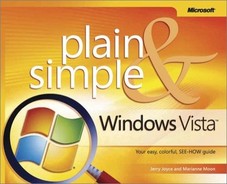In this section:
Windows Vista provides the flexibility you need to make changes, fix problems, and make your computer work better. With an administrative account, you can create or delete user accounts. If you want to squeeze more items onto your Desktop, you can increase its "virtual" size by changing the screen resolution.
Windows Vista helps you to control the power options on your portable computer, and it provides tools to help you run presentations without embarrassing snafus. Windows also provides disk-maintenance tools to help your computer run at its best. You can schedule these tools to run periodically—they’ll find and re-order bits of files that have become scattered or lost, delete unused files, and so on. We’ll show you how to get free software and how to remove software you don’t want. If Windows won’t start properly, you’ll find solutions in this section that will either get your computer started or help you diagnose what’s wrong. If you want to reverse changes you’ve made to your system, the System Restore tool will restore your previous settings. We’ll also talk about recognizing and removing spyware, and show you how to upgrade to a different version of Windows Vista if the one you have doesn’t meet your needs.
If you are a member of the Administrator group or can authorize administrative permission, you can grant other people access to the computer by creating new user accounts and specifying what type of access the new users will be allowed. To keep things tidy, you can also delete user accounts that are no longer being used.
 Click the Start button, choose Control Panel from the Start menu, and, in the User Accounts And Family Safety section, click Add Or Remove User Accounts. In the Manage Accounts window that appears, click Create A New Account to display the Create New Account window.
Click the Start button, choose Control Panel from the Start menu, and, in the User Accounts And Family Safety section, click Add Or Remove User Accounts. In the Manage Accounts window that appears, click Create A New Account to display the Create New Account window. With the Standard User option selected, click Create Account.
With the Standard User option selected, click Create Account. In the Manage Accounts window that appears, click the new account and, in the Change An Account window, change the picture, add a password, or set up parental controls for the account.
In the Manage Accounts window that appears, click the new account and, in the Change An Account window, change the picture, add a password, or set up parental controls for the account.
 Click the Start button, choose Control Panel from the Start menu, and, in the User Accounts And Family Safety section, click Add Or Remove User Accounts. In the Change An Account window that appears, click the account you want to delete.
Click the Start button, choose Control Panel from the Start menu, and, in the User Accounts And Family Safety section, click Add Or Remove User Accounts. In the Change An Account window that appears, click the account you want to delete. In the Delete Account window that appears, click Keep Files if you want all the files in that account’s folders saved to a Desktop folder, or click Delete Files to delete all the files.
In the Delete Account window that appears, click Keep Files if you want all the files in that account’s folders saved to a Desktop folder, or click Delete Files to delete all the files.
Tip
When files are saved for an account that’s being deleted, the files are saved to the Desktop of the person who’s deleting the account and are accessible only when that person is logged on.
See Also
"Know Your Rights" and "Restricting User Rights" for information about the reasons you should create only Standard user accounts.


